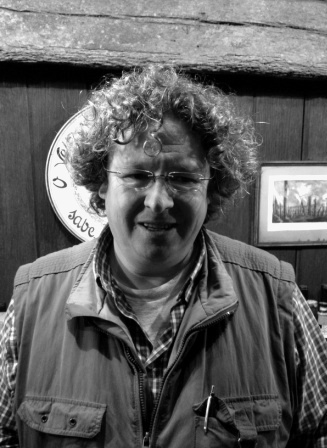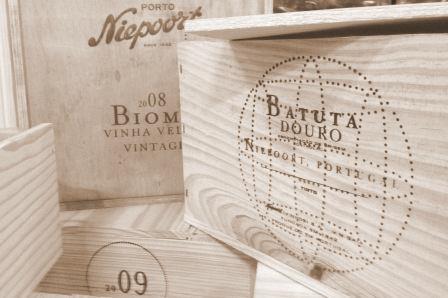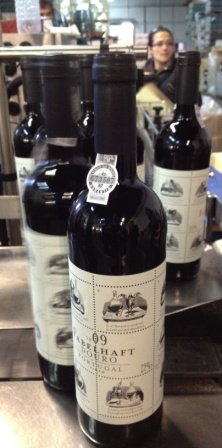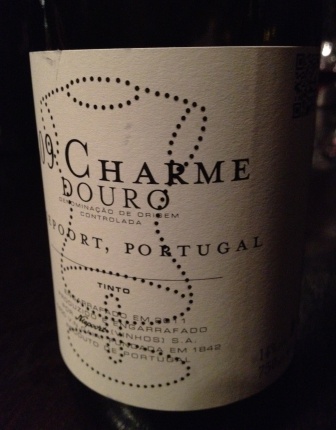Profile: Dirk Niepoort
(by peter)
 ‘No one really understands me,’ muses Dirk Niepoort, standing in the half light of his Vila Nova de Gaia cellar.
‘No one really understands me,’ muses Dirk Niepoort, standing in the half light of his Vila Nova de Gaia cellar.
‘But life could be worse.’ It’s difficult to tell, in the gloom, whether it’s a wry smile or a taut grimace on his face. Either way, his eyes gleam momentarily and then he’s away, off into the bright spring sunlight of Vila Nova, shoulders hunched, bottles in hand, shaggy hair bobbing with his gait.
Such disarming moments are common with Niepoort.
This thoughtful, provocative winemaker is used to ploughing his own furrows; in doing so, he’s become recognised as one of the most inventive and progressive winemakers on the modern Portuguese scene, if not globally. He has an engaging sense of humour which, allied to a fiercely analytical brain and notable commercial guile, makes for quite a subject.
I spent some time with him when I was recently in Portugal. Over a tour of his cellars, a tasting and lunch, I found him to be a man brimming with ideas and incisive thinking, certainly not afraid to speak his mind.
I didn’t always agree with his views – just as I wasn’t won over by all of his wines – but in both fields he is constantly challenging, provocative and engaging.
He’s also very hard working. Researching Niepoort’s wine range is like mapping Byzantium: he has myriad mini projects on the go in addition to his core range – which includes ports and still table wines, around 1.5m bottles annual production in all. This in addition to a punishing travel schedule – he estimates he’s on the road around 170 days in a year – plus the usual 50 days of harvest per year, not to mention the family commitments (including a tea importing business…)
‘People ask me why I make so many wines,’ Niepoort says. ‘My reply is that I’m not as clever or educated as some people. My way of learning is by doing.’
 One of his newest projects is in Bairrada, making Baga with Quinta de Baixo in Bairrada.
One of his newest projects is in Bairrada, making Baga with Quinta de Baixo in Bairrada.
‘I love Baga, it’s my disease,’ he enthuses dryly. ‘It’s like Nebbiolo in Piedmont or Pinot Noir in Burgundy: it needs the right plot and proper handling in the winery. Baga and Bairrada are the best combination in Portuguese red.’
When asked what makes his approach different from others, he cites a strict attention to detail. To this you could add a healthy appetite for risk taking. Take his commitment to using stems in red winemaking – something many winemakers run a mile from, for fear of making astringent, green wines.
‘The basis of good wine is a bit of green-ness,’ states Niepoort baldly. ‘It’s the same as freshness. It helps a wine age. I don’t believe in fruity wines. Although there’s no recipe, using stems can give firmer, more sexy tannin, and help eat up the fatness of wines.’
He sums up his winemaking style in the following terms: ‘I look for balance, elegance and authenticity.’ He recognises the incongruity of his aim in the Douro, an area famous for making Port, one of the most powerful wine styles around. ‘In theory, what I’m trying to do is nonsense: make vintage port that tastes like red Burgundy. I love surgical precision and elegance in my wines.’
However crazy the theory, his wines do him credit. Charmes, his most Burgundy-like Douro red, and his super-fine vintage port, are two of the stand-outs in his portfolio. Clearly the ambition translates into fine wines.
 Niepoort is no fan of natural wines, nor what he calls ‘global wines’.
Niepoort is no fan of natural wines, nor what he calls ‘global wines’.
‘We live in a world where wines taste more and more the same: ‘global wines’. Our society loves noise – the noisier the wine, the better. People don’t have time to understand things. I don’t like natural wines because they’re the same as global wines: they taste of who made them and how they were made. I want to taste terroir: where the wine has come from.’
He’s scathing about the new generation of Portuguese winemakers. While he concedes there are some bright sparks out there, he, ‘would have expected more. There’s no invention. People are all doing things by the book, making over-ripe, crap wines. They have to be more fundamental, go the whole hog.’
Part of Niepoort’s concern is the tendency for winemakers to use international varieties and overly promote, for example, Touriga Nacional, which in his view risks undermining the significant diversity of indigenous vines that is one of the country’s strongest suits.
‘Portugal’s the most interesting wine country in the world!’ he exclaims, expansively. ‘But we could do better.’
It’s a classic Niepoort comment: bold, provocative, but also fiercely self-aware. Much like the man.
TASTING
- The following are my favourite wines from several I tasted with Dirk in Vila Nova in mid-February (2012).
Redoma Branco 2010, Douro, 13.5% – this was a cool, high-yielding year which Dirk described as good for whites – fresh acids, ripeness at lower alcohols – and not so good for port. This is mainly Rabigato, a field blend from old vines with 100% barrel ferment. Lovely aromas of blanched nuts and tangerine pith. Soft, nutty, creamy. Very good. Not steely but nice persistence. Well made. 6.5-7/10
Redoma Reserva Branco 2010, 13.5% – a selection of the best barrels from older vineyards. Ten months in barrel, wild yeasts. Subtle earthy, stony nose. Lovely palate; elegant, herbal scented, limpid. Excellent integration. Very pleasant white. Could have more structure but well worked. 7(-7.5)/10
Redoma Rosé 2010, 13% – Dirk introduces this wine by announcing he ‘likes a bit of funkiness in his wines’, especially in whites and rosé. It’s another highly individual wine: mainly Tinta Amarela picked early, picked specifically for this wine, with 40% fermented in new barrels. It has a leafy, peppery aroma and a serious, savoury palate with decent concentration. A very serious dry style, yes with rough edges, and a bit watery on the finish, but overall a gallant, characterful style. Very nice. 5/10
Redoma 2008, Duoro, 13.5% – mainly Tinta Amarela from north-facing vineyards: ‘It’s our most authentic wine’, comments Dirk. ‘It’s not trying to be the best or finest – it has character, edges, a bit of a wild side – but a faithful representation of the Douro’. Lovely fresh cherried and floral aromatics. Firm tannins, with a serious, savoury undercurrent. Spicy. Some yeasty, malty notes. Seems young but nicely scented. Not the most complex but nicely crafted. I preferred this to the warmer 2009 vintage, which was a bit baked, if still decent. 6.5-7/10
 Batuta 2009, Douro, 13.5% – ‘Philosophically,’ says Dirk – it’s a word he uses a lot – ‘Batuta is different from Redoma. It wants to be the best wine in the world…’ Similar vineyards to Redoma, north-facing, high elevations, but older (at least 80 years in age). Lovely dark fruit aromas lead into a rich, dense palate that’s not at all sweet. Impressive, gently bittersweet. Notable textural elegance and savoury character. Has a vibrancy yet gentleness to it that typifies many of these reds. 7/10
Batuta 2009, Douro, 13.5% – ‘Philosophically,’ says Dirk – it’s a word he uses a lot – ‘Batuta is different from Redoma. It wants to be the best wine in the world…’ Similar vineyards to Redoma, north-facing, high elevations, but older (at least 80 years in age). Lovely dark fruit aromas lead into a rich, dense palate that’s not at all sweet. Impressive, gently bittersweet. Notable textural elegance and savoury character. Has a vibrancy yet gentleness to it that typifies many of these reds. 7/10
Doda 2008, 13.5% – a blend fruit from Douro and Dão, made in collaboration with Alvaro Castro. Dão gives the fresh acidity, Douro the richness. Dense, fluid flavour profile, firm in structure and beautifully integrated spice. Lovely aromas of wood smoke, dried herbs and fresh damson. Fluid, cogent. Grown-up stuff. Needs time to improve but very impressive. 7.5/10
Charme 2008, Douro, 14% – elegance and finesse are the aims with this wine, according to Dirk – and it pays off. This is a beautiful wine, with heavenly scents of warm earth, wood smoke and hedgerow fruits. Evocative. On the palate it’s a bit oaky but a wonderful combination of lightness with savoury density. Really the one wine that encapsulates Dirk’s vision of acidity, lightness and drinkability in reds. I’d love a notch less oak and alcohol, but even so it’s lovely stuff. Made from a cooler vintage, with source from old vines mainly in the Pinhão valley, 100% foot trodden and made with 100% stems. 7.5-8/10
Niepoort 2009 vintage port, 20.5% – ‘In theory the best wine I’ve ever made,’ muses Dirk. ‘It has soul.’ Brooding wine with minty, camphor edge to it above the roasted dark fruit and bergamot flavours. Spicy, dense, fiery and young. Lovely tannin. Very impressive, even though the aromas are slightly surprising. Pure, direct, vigorous. A baby yet, though. (8/10)
Niepoort 30-year-old tawny, 20.5% – piercing aromas of muscovado sugar and fresh malt. Punchy, rich and fiery on the palate. Vivid, albeit a bit raw. 7.5/10
